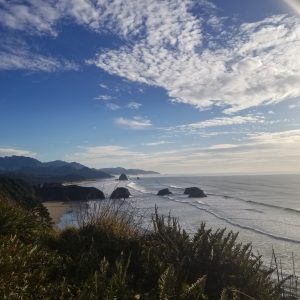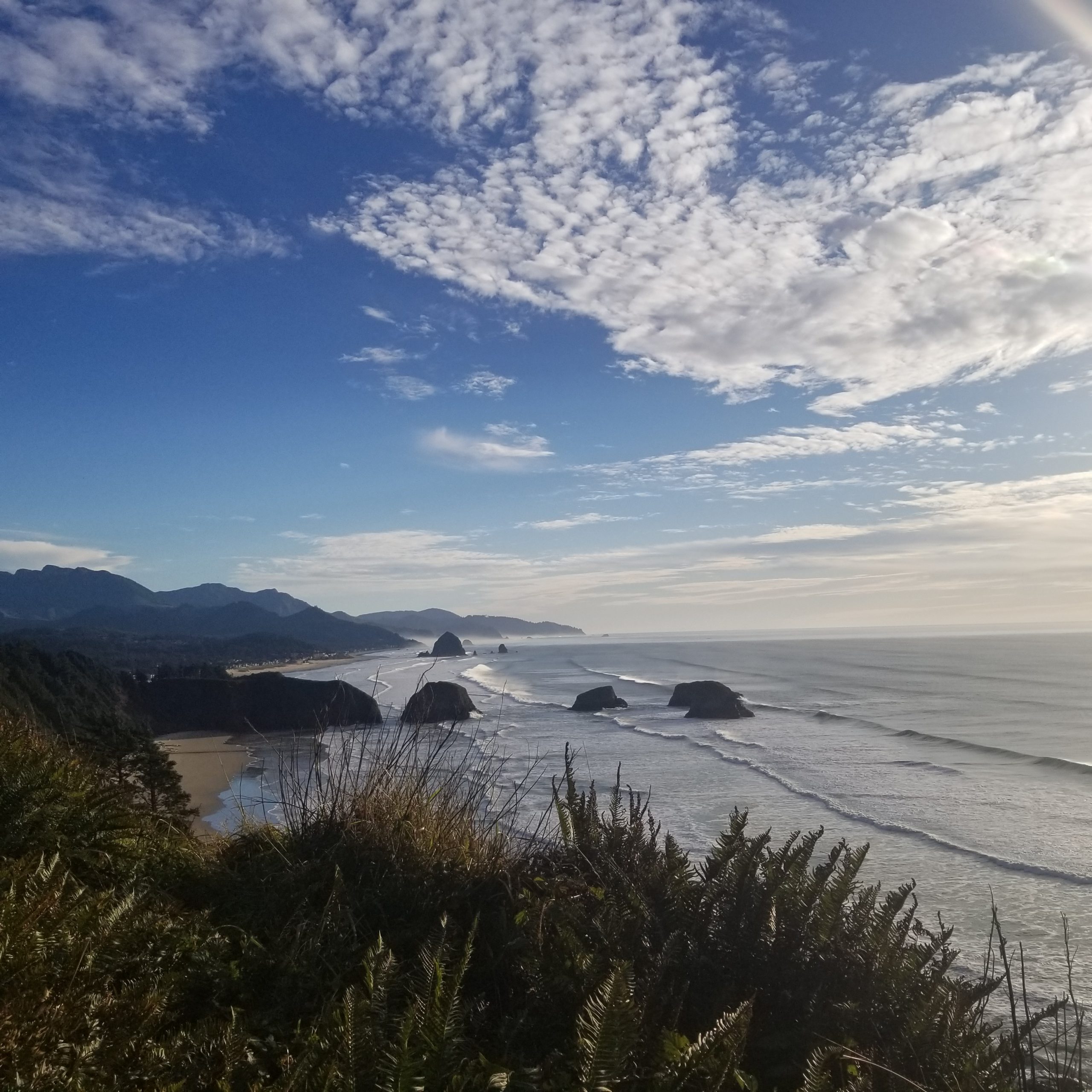By Cara Mico, for the Pioneer
Residents and visitors to the Oregon coast are likely aware of the magic that is Ecola Point, Chapman Point, Cape Lookout, and Cape Foulweather. These areas serve as crucial haul-out sites for seals and sea lions, home for nesting seabirds, many of which are considered important by the United States Fish and Wildlife Service, and provide myriad creatures with food and essential habitat. But increases in visitation to the coast as well as the impending compounded impacts from climate change has left many worried that these special places won’t survive without management intervention.
Like all US states with a coast line, Oregon’s shore management is guided by a territorial sea plan, a component of which includes guidance for management of rocky shore habitats. Oregon has long been ahead of the curve in protecting these sensitive ecosystems, both from development and from misuse. The Rocky Shores Habitat Management Strategy is one such mechanism that protects Oregon’s beaches. The Strategy provides policies and guidance for the protection of unique ecosystems along the Oregon coast including site-specific, scientifically supported recommendations which strongly rely on local, state and federal agencies to implement the recommendations.
The overall goal of the Strategy is to maintain, protect, and restore rocky habitats and their associated biological communities using a holistic management program which includes site designations and management recommendations protecting sensitive Rocky Shore Habitats from degradation and loss. Other goals include increasing public awareness and enhancing appreciation of Oregon’s rocky habitats through education and research.
The Territorial Sea Plan, which was adopted in 1994, didn’t provide much opportunity for adding new areas to the list and it wasn’t clear how the public could become involved in that process.
That changed two years ago when the Department of Land Conservation and Development and the Ocean Policy Advisory Council began gathering state conservation leaders and land managers to amend the Territorial Sea Plan to allow for updates to where and how the designations are made. Find out more about the Rocky Shores Habitat Management Strategy update here.
Michael Moses of the DLCD is coordinating the team updating the Territorial Sea Plan and shared some high level insight into what the future of adding designations might look like.
“The Oregon Ocean Policy Advisory Council (OPAC, a legislatively mandated marine policy advisory body) brought to the Governors office’s attention that the Strategy was out of date. Because the management strategies remained frozen in time, over time those recommendations became out of phase with management practices on the ground,” said Moses.
As public use and climate change has become more prevalent it became clear to OPAC that the strategy needed not only to be amended but that the process to amend the plan needed adjustment to better match adaptive management strategies already in place in other land management agencies. OPAC convened a rocky habitat working group to oversee an overhaul of the Strategy’s language, outline simpler designations more in line with science, and recommend a new process to designate sites using a publicly driven process.
“From the biological side, each site is unique, not all habitats are quite the same. From the scientific perspective, there are variations regarding the amount of substrate, tidal variations, nutrient delivery, it’s not consistent what the needs might be. And it’s not exclusively about conservation, there are other purposes to manage for. On the state side of things there are the needs of the citizens. We need more targeted management prescriptions, we can’t manage a site like Haystack Rock in the same way as a place south of Port Orford,” Moses said about the importance of adaptive management practices.
As part of this update process the public has been invited to propose changes to management designations at rocky habitat sites, this not only opened up the ability to change how existing sites are used but also to add new sites to the management strategy. Several proposals throughout the coast have already been or are in the process of being submitted, including for Chapman and Ecola Points as well as Cape Lookout and Cape Foulweather.

Margaret Treadwell, a volunteer for the Coalition, said that the community didn’t want to see the area “as new Haystack Rock,” which might increase visitorship in ways that the area can’t support.
A Marine Conservation Area designation would reduce the harvesting of tide pool animals and limit wildlife disturbances from drones and dogs, something that is already in place at many of Oregon’s most iconic ocean habitats such as Haystack Rock. The designation would reduce disturbances to nesting birds and bird mortality by requiring dogs to be on leash, as well as ban drones and fireworks outright. The designation would also allow for the creation of an educational program with signs showing the location of sensitive bird habitat and providing spotting scopes for residents and visitors to birdwatch.
Although the proposal will be submitted at the end of this year, it will likely take some time to work its way through the policy process. There are at least 5 governing bodies that will review all the proposals for special designations and it might take up to two years to complete that process.
“It’s hard to see where this will go,” Treadwell, who is spearheading the proposal, said.
“If you look at the Marine Reserve designation process as an example and how many proposals were submitted versus how many were approved, it’s likely about 20 proposals to 5 approvals, that could be an indication. These are smaller areas though and they don’t have as much impact on fishing because they aren’t as big and don’t include fishing areas so it might not be as contentious. This is the first time this has been done for rocky shores and I think it’s a strong proposal. It’s a spot with conserved land and ocean so it makes sense for interconnectivity in that they can support each other,” Treadwell added.
Moses expects that there will be somewhere between 10 and 15 proposals submitted in this first round. “It speaks to the level of passion, investment, and engagement,” said Moses of the overwhelming public involvement already taking place.
Volunteer Frances Buchanan has been working in marine conservation for over nine years, and is another local resident working on the new designation for Chapman Point. “The ocean has always been really been important to me,” said Buchanan.
The abundance and diversity of sea life at Chapman Point motivated Buchanan to work to educate the public about why the area deserves a special designation.
“I noticed a diversity of sea life outside of the rocky intertidal zone, it’s the interconnectedness of the ecosystems. There are harbor porpoises, 25 different species of marine mammals, a Pacific gray whale migration around the new year; I saw about 150 whales just by pulling off the road in Cannon Beach,” added Buchanan.
Chapman Point, adjacent to the Ecola State Park, is a unique place on Oregon’s north coast where sharks, sea turtles, and other wildlife all congregate to feed, breed, and live in the diversity and abundance of the intact rocky shoreline habitat. It’s culturally important as well with many people using the location for hunting and fishing for countless generations.
Prompted by recent high failure rates of Black Oystercatcher nests amongst other concerns, the Coalition is proposing the new designation largely because of the areas increased activity, traffic, and visitation. People coming for relaxation and rejuvenation are leaving behind injured animals, trash, and damaged habitats.
The Coalition’s goal is to come to a consensus as to how this sensitive place should be managed going into the future. Stakeholders and community members were invited to attend their first meeting which was held remotely this year and provided valuable feedback to ensure that local uses were taken into consideration when drafting the proposal.
Treadwell added that the group hasn’t encountered much in the way of opposition, “so far we’ve had few concerns mentioned by local community members around how the designation will work in our community. We’ve gotten more positive feedback than negative feedback, including from local conservation nonprofits and watershed councils, the Cannon Beach City Council, although they still want more information, and we’ve received a lot of support letters already. On the one hand we’re really thinking about visitor impacts on wildlife and natural areas, it’s not about not letting people enjoy it but more about providing a mechanism so that people can enjoy the area with as low impact as possible. That’s where the stewardship component comes in, by educating people in a kind way how to properly behave. But we’re keeping a balance of uses in mind, we don’t want to just shut down the area to everyone.”
Retired ODFW ecologist Kent Doughty and Cloverdale resident has been working with the Lincoln City Audubon Society to help with their Rocky Shores Habitat Management Strategy proposed addition of Cape Lookout and Cape Foulweather.
“Cape Lookout stood out because it was designated in 2004 but never implemented. In the 1994 process it was designated but because it was mostly cliffs, not easily accessible and already designated a State Park they felt it didn’t need additional protection,” said Doughty.
However much has changed since 1994 including our awareness of ecology and climate change. While the designation of both Capes as Marine Conservation Areas won’t change existing uses, including commercial and recreational fishing or shellfishing of the most common species, a designation will provide much needed resources to engage the public, raise awareness around stewardship, and help local managers coordinate on conservation projects.
If you would like to support the North Coast Rocky Shores Coalition’s efforts send a letter to northcoastrockyhabitat@gmail.com by December 18, 2020, 5:00 pm. All letters will be submitted to the Rocky Habitat Working Group with the Coalition’s proposal on December 31 of this year.
address your letter to: Rocky Shores Habitat Working Group and Ocean Policy Advisory Council members.
The Audubon Society is also seeking letters of support for their proposals. You can send letters of support regarding the Cape Foulweather and Cape Lookout proposals to Info@lincolncityaudubon.org by this Friday, the 18th, at 5:00 pm.
You can submit general public comment to DLCD about the overall process by emailing tsp.comments@state.or.us by December 31, at 5:00 pm.
The process is expected to wrap up review of this first round of updates by September 30, 2021.
The working group anticipates immediately opening up the process for new proposals on the following day.


